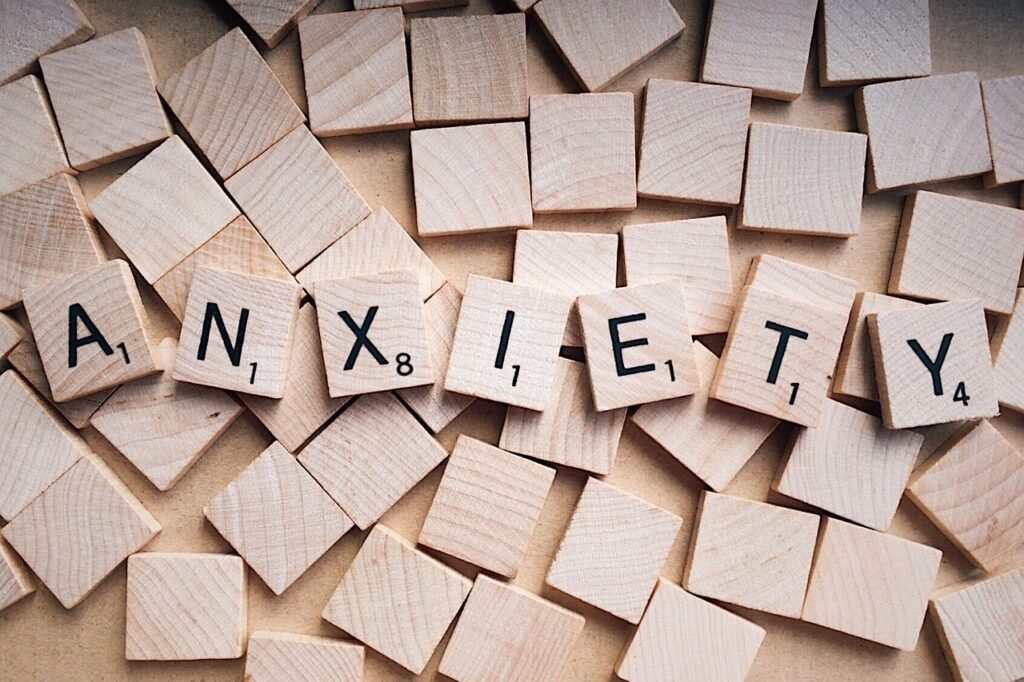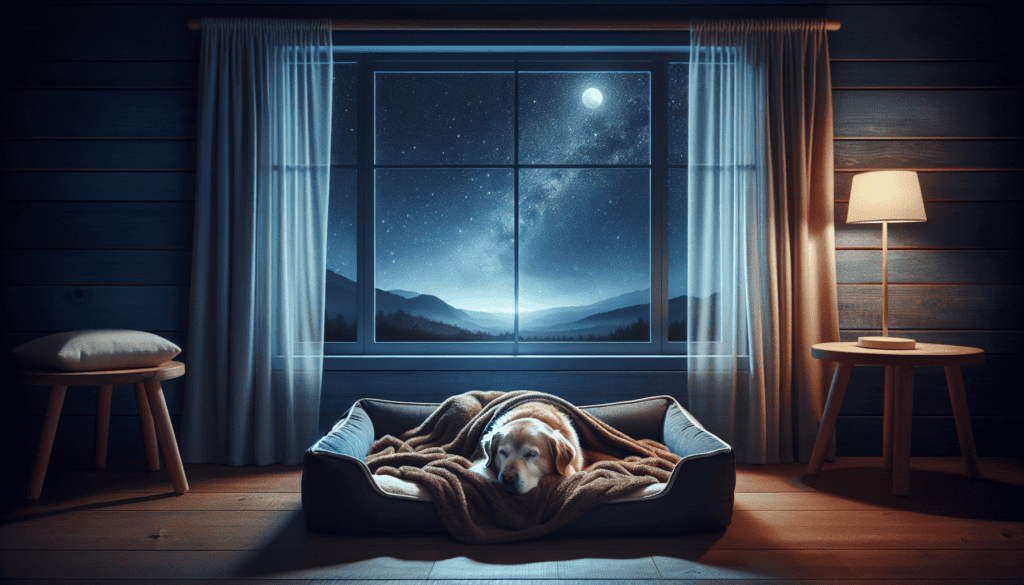If you have a furry friend who struggles with nighttime anxiety, you may find yourself wondering, “How can I create a calming bedtime routine for my dog?” It’s a common concern among pet owners, and fortunately, there are a few simple steps you can take to help ease your dog’s anxiety and ensure a peaceful night’s sleep for both of you. By incorporating calming activities and establishing a consistent bedtime routine, you can create a soothing environment that promotes relaxation and reduces nighttime anxiety for your beloved canine companion.

This image is property of pixabay.com.
Establish a Consistent Schedule
Having a consistent schedule is crucial for helping your dog with nighttime anxiety. Dogs thrive on routine and predictability, so setting a regular bedtime and following a consistent routine can provide a sense of security and comfort.
Set a regular bedtime
Choose a specific time for your dog to go to bed each night and stick to it. Consistency is key here, as it helps regulate their internal clock and signals to their body that it’s time to wind down and prepare for sleep. Establishing a routine around their bedtime will further reinforce this signal.
Follow a consistent routine
Create a calming routine leading up to bedtime that you follow every night. This routine can include activities such as a pre-bedtime walk, brushing their fur, or some gentle playtime. The key is to keep the activities low-key and soothing to promote relaxation. By following a consistent routine, your dog will learn to associate these activities with bedtime, which can help them feel more secure and less anxious at night.
Create a Soothing Environment
The environment in which your dog sleeps plays a significant role in their overall comfort and relaxation. By making their sleeping area as soothing as possible, you can help alleviate their nighttime anxiety.
Make the bedroom comfortable
Ensure that your dog’s sleeping area is comfortable and cozy. Invest in a quality dog bed that provides support and warmth. Consider the size and shape of the bed to ensure it suits your dog’s preferences. Additionally, provide soft blankets or pillows that they can snuggle up with. Creating a comfortable sleeping space will contribute to a restful night’s sleep for your furry friend.
Use calming scents
Certain scents can have a calming effect on dogs, so consider incorporating them into your dog’s sleeping area. Lavender, chamomile, or other dog-friendly essential oils can be used to create a calming atmosphere. You can use a diffuser or spray these scents in the room, or even add a few drops to their bedding. Just ensure that the scents you choose are safe for dogs and not overpowering. The pleasant scent will help create a soothing environment and promote relaxation for your dog.
Engage in Relaxing Activities
Engaging your dog in relaxing activities leading up to bedtime can help their mind and body unwind, reducing their anxiety levels.
Take a leisurely walk
A leisurely walk in the evening can be a great way to help your dog relax before bed. Walking not only provides physical exercise but also mental stimulation as your dog explores their surroundings. It allows them to release any pent-up energy and can tire them out, making it easier for them to settle down at bedtime. Just ensure that the walk is calm and not overly stimulating.
Practice gentle massage or petting
Physical touch can be incredibly soothing for dogs, just as it is for humans. Before bed, spend some time gently massaging or petting your dog. Focus on areas that they enjoy, such as behind the ears or along the back. This physical contact will help release feel-good hormones and promote relaxation. Combining massage with soft, gentle music or white noise can create an even more peaceful atmosphere for your dog.
Provide Mental Stimulation
Mental stimulation is essential for keeping your dog’s mind sharp and engaged, especially if they struggle with nighttime anxiety. By providing mental challenges during the day, you can tire out their brain and reduce their anxiety levels at night.
Use puzzle toys
Puzzle toys are a great way to provide mental stimulation and keep your dog’s mind occupied. These toys often involve treats or hidden compartments that require your dog to figure out how to access the reward. When your dog is mentally engaged, they are less likely to focus on their anxiety. So consider investing in some puzzle toys that are suitable for your dog’s size and breed.
Engage in brain games
In addition to puzzle toys, you can also engage your dog in brain games and training exercises. Simple tasks like teaching them new tricks or playing hide and seek with treats can keep their mind active and tire them out mentally. The more mentally exhausted they are, the more likely they are to relax and sleep peacefully at night. So, set aside some time each day to challenge and stimulate your dog’s brain.

This image is property of pixabay.com.
Avoid Stimulating Activities
While it’s important to engage your dog in activities to promote relaxation, it’s equally important to avoid stimulating activities that can ramp up their energy levels and anxiety.
Limit screen time
Just like humans, dogs can be stimulated by screens. It’s best to limit your dog’s exposure to screens and avoid having them in the bedroom before bedtime. The bright lights and fast-paced visuals can increase their alertness and hinder their ability to relax. Instead, opt for calming activities or gentle playtime to wind down before bed.
Avoid energetic play before bedtime
While playtime is essential for physical and mental exercise, it’s crucial to time it appropriately. Avoid engaging your dog in energetic play or high-energy activities close to their bedtime. This can rev them up and make it difficult for them to settle down. Instead, opt for low-key play or gentle activities that promote relaxation in the hours leading up to bedtime.
Practice Positive Reinforcement
Positive reinforcement is a powerful tool to encourage calm behavior in your dog and alleviate their anxiety.
Reward calm behavior
Whenever your dog exhibits calm behavior, whether it’s during bedtime or throughout the day, make sure to reward them. This can be as simple as offering a treat, giving them praise, or offering a gentle pat on the head. Positive reinforcement reinforces their association between calmness and positive outcomes, which can help reduce their nighttime anxiety.
Use treats and praise
Treats and praise can be effective rewards for dogs. Use small, healthy treats that your dog enjoys to reinforce their calm behavior. Combine treats with verbal praise or gentle petting to further communicate your approval. By consistently rewarding your dog’s calm behavior, you can reinforce the habit of relaxation and create a positive bedtime routine.

This image is property of pixabay.com.
Use Calming Products
There are various products available that can aid in calming your dog and reducing their nighttime anxiety.
Try anxiety wraps or vests
Anxiety wraps or vests, such as Thundershirts, can provide a gentle, comforting pressure that helps soothe your dog’s anxiety. The snug fit of these wraps mimics the feeling of being held or hugged, which can have a calming effect on dogs. Consider trying an anxiety wrap or vest for your dog to see if it helps alleviate their nighttime anxiety.
Consider pheromone diffusers
Pheromone diffusers, like Adaptil, release synthetic versions of calming pheromones that mimic those naturally produced by mother dogs. These pheromones create a sense of security and can help reduce anxiety in dogs. Consider using a pheromone diffuser in the room where your dog sleeps to help create a calm and relaxing environment.
Consult with a Veterinarian
If your dog’s nighttime anxiety persists despite your efforts to establish a calming bedtime routine, it may be beneficial to consult with a veterinarian.
Discuss medication options
Certain medications can help alleviate anxiety in dogs. A veterinarian can assess your dog’s specific needs and recommend appropriate medication options. Medication should always be used under the guidance and supervision of a veterinarian to ensure safety and effectiveness.
Consider behavioral therapy
In addition to medication, a veterinarian may also suggest behavioral therapy for your dog. This may involve working with a professional dog trainer or behaviorist who specializes in anxiety-related issues. Behavioral therapy can help address the underlying causes of your dog’s anxiety and provide them with the tools to cope with it in a healthier way.

Monitor Diet and Feeding Times
Your dog’s diet and feeding times can impact their overall well-being, including their anxiety levels. Making some adjustments in this area can help promote a calming bedtime routine.
Avoid stimulating ingredients
Certain ingredients in your dog’s food can have a stimulating effect, potentially exacerbating their anxiety. Avoid foods with high levels of artificial additives, preservatives, or excessive amounts of sugar. Opt for high-quality, balanced dog food that is free from these ingredients and promotes overall health and well-being.
Establish regular mealtimes
Establish a consistent feeding schedule for your dog. Feeding them at the same times each day helps regulate their digestion and overall body clock. Ensuring they have had their meal a few hours before bedtime gives them ample time to digest and reduces the likelihood of discomfort, promoting a more peaceful night’s sleep.
Provide a Comforting Bed
Creating a designated sleep area for your dog is essential for their comfort and relaxation.
Choose a cozy and supportive bed
Invest in a high-quality dog bed that offers both coziness and support. Consider your dog’s size, breed, and sleeping preferences when choosing the right bed for them. Look for materials that are soft, yet durable, and provide proper orthopedic support. A comfortable bed can significantly contribute to your dog’s relaxation and overall well-being.
Make it a designated sleep area
Designate your dog’s bed as their dedicated sleep area. Encourage them to associate this space with relaxation and downtime by consistently using it for their sleep and rest periods. Avoid using their bed for play or as a place for them to store toys. By establishing their bed as a designated sleep area, you reinforce the idea that it’s a safe and calming space for them to unwind and sleep.
By following these tips and implementing a calming bedtime routine for your dog, you can help alleviate their nighttime anxiety and promote a more restful sleep. Remember, consistency, comfort, and positive reinforcement are key in creating a soothing environment that will help your dog relax and feel secure at night. Consulting with a veterinarian can also provide valuable guidance and support in managing your dog’s anxiety. With time and patience, you can create a peaceful bedtime routine that benefits both you and your furry friend.


